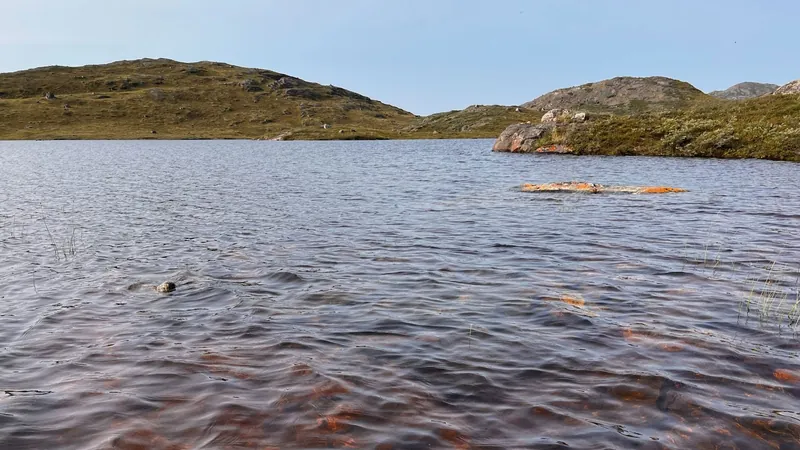
Alarming Transformation: Greenland's Lakes Turn Brown and Start Emitting CO2 Amid Climate Crisis
2025-01-24
Author: Ming
Introduction
In a startling revelation, thousands of pristine blue lakes in Greenland have transformed into murky brown bodies of water due to the devastating impacts of climate change. As if this transformation was not alarming enough, these lakes have begun to release carbon dioxide into the atmosphere, further exacerbating global warming.
The Impact of Climate Change
A 2022 heatwave, marked by record temperatures and unusual rainfall patterns, pushed the lakes of West Greenland past a critical tipping point. Instead of functioning as carbon sinks that absorb CO2, these lakes have flipped roles and are now contributing to greenhouse gas emissions, according to recent research published in the journal PNAS.
Environmental Changes
In a pattern typically dominated by snow and ice, the fall of 2022 saw an unprecedented rise in temperatures that caused snow to melt into rain, warming the permafrost—an essential reservoir for carbon and minerals. This meltwater transported carbon-rich organic matter into the lakes, darkening their waters and disrupting their delicate ecosystems.
Effects on Plankton and Ecosystems
As the lakes grew darker, sunlight penetration decreased, adversely affecting the microscopic plankton populations that usually thrive in these waters. This decline reduced the amount of CO2 absorbed through photosynthesis while increasing the carbon released due to decomposition—a drastic shift in the biological processes within the aquatic environment.
Scientific Concerns
Researchers involved in the study were astonished by the rapidity of this transformation. Jasmine Saros, a leading expert in paleolimnology and lake ecology at the University of Maine, remarked, 'The magnitude of this and the rate of change were unprecedented.' Such rapid changes, which usually take centuries to evolve, have occurred over a mere season—sparking major concerns within the scientific community.
Atmospheric Conditions
The atmospheric conditions that led to this unusual warming were driven by a combination of air circulation patterns and hurricanes forming atmospheric rivers, which transported enormous amounts of heat and moisture from subtropical regions to Greenland. Climate models warn that the frequency and intensity of these atmospheric rivers will likely increase with ongoing global warming, amplifying the risks faced by already vulnerable ecosystems.
Local Community Impacts
Approximately 7,500 lakes have been observed to have turned brown and emitted carbon following the fall of 2022. However, the implications of this shift extend beyond carbon emissions—these lakes are crucial sources of drinking water for local communities. The influx of dissolved organic materials threatens water quality, promoting harmful bacteria growth and potentially leading to health risks from increased levels of metals and other contaminants in drinking water supplies.
Health Risks
Moreover, these changes could lead to the formation of trihalomethanes, a group of chemicals associated with cancer risks, as dissolved materials interact with water treatment processes. 'What is happening to these lakes is a wake-up call for us all,' Saros highlighted in her comments.
Conclusion
As the summer of 2024 unfolds, the once-vibrant lakes remain brown, with little clarity about the timeline for their potential recovery. Scientists and environmentalists urge that concerted global action is crucial to mitigate the effects of climate change and protect vulnerable ecosystems like those found in Greenland, igniting fears of a tipping point that may have dire consequences well beyond the Arctic region.
Stay tuned as researchers continue to monitor this developing situation with implications that could resonate worldwide.
 Brasil (PT)
Brasil (PT)
 Canada (EN)
Canada (EN)
 Chile (ES)
Chile (ES)
 Česko (CS)
Česko (CS)
 대한민국 (KO)
대한민국 (KO)
 España (ES)
España (ES)
 France (FR)
France (FR)
 Hong Kong (EN)
Hong Kong (EN)
 Italia (IT)
Italia (IT)
 日本 (JA)
日本 (JA)
 Magyarország (HU)
Magyarország (HU)
 Norge (NO)
Norge (NO)
 Polska (PL)
Polska (PL)
 Schweiz (DE)
Schweiz (DE)
 Singapore (EN)
Singapore (EN)
 Sverige (SV)
Sverige (SV)
 Suomi (FI)
Suomi (FI)
 Türkiye (TR)
Türkiye (TR)
 الإمارات العربية المتحدة (AR)
الإمارات العربية المتحدة (AR)